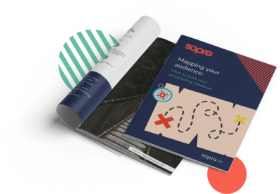A comprehensive guide to building a prospecting list

Forget the numbers game. Building an accurate prospecting list is the foundation of successful outreach campaigns. Here, we outline a variety of approaches to help you contact your ideal prospects.
A carefully crafted prospecting list is the linchpin for effective outreach and sustained growth. So we’re sharing the key strategies to help you assemble the perfect prospecting list, and your outreach success.
From defining your ideal customer profile to advanced filtering tools, we’re on hand to provide insights that transform data into actionable connections.
It can be a daunting task, but it doesn’t have to be a slog! We’ll outline how to construct a prospect list that help you develop connections and maximise return on investment.
We’ll outline the four key pillars of any good sales prospecting list:
- Comply with all relevant data protection laws
- Target only the right people for your business
- Decide which channels you want to contact them on
- Find and verify their current contact information
Make sure your data is compliant from the start
When managing data, strict adherence to compliance obligations is crucial. For prospects in Europe, you’re likely already familiar with the General Data Protection Regulation. GDPR is a comprehensive framework designed to safeguard individuals’ privacy and personal data across Europe.
But different regulations will apply depending on where your prospects are based. A sea of initialisms awaits you: PECR, CAN-SPAM, CCPA, TCPA… the list goes on.
For businesses handling the data needed to construct a prospecting list, compliance with these regulations is not just a best practice; it’s a fundamental necessity. Failure to follow these rules could expose your business to financial and reputational consequences. Building a prospecting list entails identifying potential leads and ensuring every step aligns with all relevant laws.
While each law has it’s own particulars, here are some best practice rules that are a good place to start:
- Only process the data you need: there must be legitimate interest.
- Have an easy-to-read privacy policy that anyone can understand.
- Regularly audit your systems to ensure they’re working as they should.
- Keep a record of who has given you data consent (and who has explicitly asked you not to contact them).
- When someone does ask you to stop contacting them, stop. Immediately.
- Seek legal advice if you’re not sure!
GDPR, for example, states you can send direct marketing communications if a “legitimate interest” is involved.
Read our post on GDPR and sales prospecting emails.
Target only the right people for your business
Precise targeting in your prospecting list is crucial to maximise efficiency and relevance. Focusing on the right audience enhances conversion rates and ensures resources are invested in the places where they make the most significant impact. This approach optimises marketing and sales efforts and fosters meaningful connections with potential clients.
So, how do you go about targeting the market that’s right for your business? It starts with a thorough understanding of your audience. That means ideal customer profiles (ICP), buyer personas, and market segmentation. Let’s get into it.
Building your ideal customer profiles
The sole purpose of building an ICP is to provide a clear picture of the businesses for which your product or service can help solve problems. Each ICP should effectively represent different business characteristics, challenges and goals. Not only this, but it will help you identify any holes in your product that hinder you from targeting a specific market.

The long and short of it is your ICP is the ideal toolkit for your marketing and sales teams. They help them identify prospects that align with these characteristics so they can categorise and prioritise leads.
Understanding your buyer personas
Your buyer personas bring together a generalised representation of your ideal customer. These are built around personal characteristics and aspects that may affect their daily business lives.
They help you identify their pain points and goals, identify where to reach them and gain insight into their part in the buying process. These steps will help you refine and drill down your targeting when building the perfect sales prospect list.

Effectively, your buyer personas are there to aid your marketing teams in mapping out and creating content.
Market segmentation
Now that your sales reps and marketing team have an accurate understanding of the type of businesses and the key decision-makers within them, it’s time to start segmenting your target market.
But why?
Potential clients want to feel like you understand their needs and wants. Splitting your lists into known characteristics helps you personalise your messaging based on those business needs. It will enable you to keep that personalisation congruent throughout the sales process. Sending the same generic message to every recipient is a turn-off and will not encourage engagement.
Analysing different types of data will help you work out the best way of segmenting your prospecting list. These insights provide a nuanced understanding of target audiences, ensuring precision in outreach strategies. Leveraging this diverse data spectrum enhances prospect list accuracy, aligning marketing efforts with audience preferences and behaviours.
What are the different types of data?
Let’s have a look at all the data that you can drill into for prospecting:
Demographic data
Personal data, such as Age, Gender, Occupation, Cultural background and Family status.
Filmographic data
Business data, such as Company name, Location, Size and Industry.
Technographic data
What technology a customer or client is using, including software and hardware.
Chronographic data
Events or company changes that happen in your target audience environment that could impact their client’s choice to buy from you, such as a significant hiring or a rebrand.
Intent data
Behavioural information relates to your prospective client or customer buying intent, such as visiting high-value pages on your website or signing up for a mailing list.
Decide where to target those people
To construct your prospecting list, you’ll need to pick which channels you want to engage those potential clients on. This decision obviously influences the data you need to collect: email addresses, phone numbers, LinkedIn profiles, etc.
Selecting channels depends on your target audience, the nature of your business, and available resources. But in today’s dynamic prospecting landscape, adopting a multi-channel approach can really elevate success.
But first, what channels should you consider when building your prospecting lists?
- Email outreach
- Calling (Warm vs cold?)
- Social media
– Social Selling
– LinkedIn Sales Navigator - SMS/Whatsapp
- Direct mail
Email outreach
Email is undeniably one of the most effective forms of outreach – and the numbers speak for themselves. It’s the number one preferred form of contact for buyers, so accordingly, 86% of sellers say it delivers “good to excellent” ROI.
It’s a direct way of reaching thousands of buyers and frees up time for your sales team. Emails are easily personalised, making buyers feel like you’re reaching out on an individual level. But it’s also the backbone of a multi-channel approach, with other forms of outreach easily layered on top.
Calling
There are two routes you can take with calling. There is, of course, cold calling, which has always been a popular form of outreach. However, due to its impersonal and time-consuming nature, yielding low results, it has decreased in favour of both buyers and sellers over the years.
However, this doesn’t mean that it needs to be abandoned entirely. More, adapted.
Warm calling is another way to make the most of your prospecting lists and highlights the importance of utilising many outreach channels. Warm calling is about tracking buyer intent – it lets you know when potential buyers browse your socials or pages on your website. Your sales reps can then make well-timed calls, being on hand to answer those important calls and queries, helping the prospect move along within the buying journey.

Cold calling and warm calling
An unbiased deep-dive into both cold and warm sales approaches
Read moreSocial media
In the B2B landscape, social selling has always been a crucial outreach tool. 75% of B2B buyers use social media for purchasing decisions. Given most of us spend around two and a half hours a day browsing social media, targeting prospects in these familiar spaces is strategic.
Crafting effective prospecting lists requires understanding the nuances of each social media channel. Each platform has unique strengths, demanding tailored approaches for optimal utilisation. By recognising these distinctions, businesses can employ a refined and targeted strategy.
Social selling: a quick look
While Facebook may not be ideal for direct messaging, it remains a valuable resource. 66% of sales reps use it to research prospects and businesses. Additionally, its robust advertising platform adds another layer of effectiveness to outreach efforts.
On the other hand, Instagram proves to be a potent tool for prospect research and market analysis. 51% of salespeople leveraging it to discover new leads. Creating an Instagram business page further enhances the depth of audience insights.
These insights highlight the importance of integrating social selling strategies when building prospecting lists. By strategically utilising both Facebook and Instagram, businesses can gather valuable information about potential clients and tap into powerful advertising avenues, ultimately optimising the approach to building effective and targeted prospecting lists.
LinkedIn Sales Navigator: A quick look
LinkedIn stands out as the star social channel for B2B prospecting. It offers the dual advantage of research and direct messaging. LinkedIn Sales Navigator is key, with 72% of sales professionals praising its effectiveness in generating more leads.
However, the high volume of outreach on LinkedIn poses challenges for standalone InMails. Their low success rate can be attributed to the lack of a prior relationship, the absence of relevant context, and the perceived impersonal nature that often associates messages with spam.
To navigate this, our innovative multi-channel approach leverages emails, gifting, and website tracking to leverage buyer intent, which is used as a trigger for InMail messages and connection requests. This strategy addresses the limitations of generic outreach, ensuring that engagement is more targeted, personalised, and aligned with the prospect’s interests. So, while LinkedIn is an invaluable platform for prospecting, employing nuanced strategies and tools becomes pivotal for successful outreach in a competitive environment.
SMS/WhatsApp Business
If you’re seeking an additional way to connect with individuals, text message prospecting emerges as a compelling solution. With an exceptionally high open rate, studies indicate that most text messages are opened within minutes of receipt.
The versatility of personalising messages and segmenting your audience based on their interests and behaviours makes SMS and WhatsApp prospecting an appealing strategy. This personalised approach can foster high engagement rates, potentially making it a valuable addition to your arsenal, and one to consider when building your prospecting list.
Direct mail
Direct mail may be a surprising addition in the digital age, but one that is making a comeback.
Modern direct mail, fueled by targeted mailing lists and personalised messaging, allows for tailored communication aligning with potential customers’ specific interests and needs. This personalised touch significantly boosts the likelihood of a positive response.
Surprisingly, 18% of companies prefer being contacted via post, a notable increase from the 7% seen in our 2023. Sopro implemented highly personalised introductory letters in internal campaigns, before sending emails and other forms of outreach. The recipients of those letters showed a 23% higher likelihood of opening subsequent emails compared to the control group who had not.
Direct mail emerges as a powerful strategy when building prospecting lists and thinking about outreach, offering a tangible and memorable touchpoint that stands out amidst the digital competition.
Find prospects’ current contact information
The next critical step is finding prospects’ contact information, based on which of the above channels you have decided to include in your outreach.
The manual approach to building a business database is a common choice, favoured by more than half of B2B companies. It is a hands-on method, demanding significant time and effort, but offers elevated control over your database.
However, the time-consuming nature makes it difficult to scale, so is only really suitable for small-scale companies. For a detailed, step-by-step run down of how to manually build your own list, check out our report on mapping your audience.

How to build your prospecting database
A practical guide to building your perfect B2B prospecting database.
Download nowNot sure you have the time to build an entire list from scratch Let’s break down the other options available.
Buying data
While buying data might seem like a quick solution for obtaining contact details, navigating the pitfalls associated with this approach is essential. According to our survey panel, 26% of respondents rely on purchased email lists for prospecting data. However, there are compelling reasons why this shortcut may not yield the best results.
One of the biggest worries is around data accuracy. Purchased data becomes outdated surprisingly quickly, as people change jobs and roles frequently. Bought lists can easily be out of date due to a lack of regular updates.
A significant concern is the need for great personalisation to build effective email outreach campaigns. 57% of companies rate their email personalisation as only “basic” or “intermediate,” often limited to just using a prospect or business name.
Furthermore, ethical considerations come into play. Verifying GDPR compliance and sourcing data relevant to your audience ensures ethical data practices. Mass, impersonalised outreach risks spam complaints and low response rates and can result in regulatory fines.
In short, creating a list that can act as foundation for great outreach means steering clear of the pitfalls associated with buying data. There are other methods that allow you to collate prospecting data that yield better results and foster meaningful connections with your audience.
With this in mind, what are your options?
Utilising social media
Direct social media outreach in the B2B world generally means LinkedIn. The advantage here is clear: most serious B2B professionals have some sort of presence on the platform, so you can find and directly contact decision-makers.
Creating a list here means using Sales Navigator and InMail to initiate cold approaches. Forget bulk downloading contact details, you’ll have to do everything on the platform. This hands-on method can be fruitful: 44% of companies use InMail for prospecting. But you’ll have to set realistic expectations regarding the scale of your results.
However, there are challenges for list building here, such as the restriction on the volume of InMails. Managing and tracking responses becomes challenging without CRM integration, and it’s crucial to adhere to LinkedIn’s terms of service and contact regulations for ethical and effective prospecting practices.
Navigating these aspects is vital to optimising your prospecting efforts on platforms like LinkedIn, ensuring you make the most of direct social media outreach for building robust and effective prospecting lists.
Using LinkedIn to build your prospecting lists: A quick walkthrough
- You still want to start by defining your ideal customer profiles and buyer personas, specifying job titles, industries, and company size.
- Leverage Sales Navigator’s search filters to identify leads that align with your established criteria.
- Organise your prospects by saving them to lists, and make the most of tagging and note-taking features to monitor your outreach efforts effectively.
- Explore the “Lead Recommendations” feature to uncover new leads that match your ICP closely.
- Enhance your lead generation and management process by integrating Sales Navigator with third-party tools like your CRM system.
- Ensure the accuracy and relevance of your prospecting lists by routinely reviewing and updating your database.
- Gauge the effectiveness of your efforts by using analytics provided by Sales Navigator. This enables you to make informed, data-driven decisions to refine your prospecting strategy.
Partner with data experts
Entrusting your prospecting to the right professionals can provide a comprehensive database, streamlining your process and enhancing results. The combination of expertise and advanced technology ensures your business gains access to accurate, current, and compliant data tailored to your niche.
According to our latest State of Prospecting report, 57% of companies acknowledge that specialised agencies optimally handle prospecting. At Sopro, our approach to building databases is intricate and thorough. Rather than relying on a single data source, our world-class technology amalgamates and validates information from diverse channels, boosting accuracy and relevance.
When a new client joins, our experts use this technology to create a unique and customised list tailored to their specific needs. The backbone of data building involves extensive website crawl data, sophisticated algorithms, big data solutions, and multiple email verification systems. With 160 different data points, we adopt a laser-focused approach to pinpoint your target persona, resulting in an extensive and highly tailored dataset.
Ensuring compliance with regulatory requirements is paramount, overseen by our in-house Compliance Officer. Partnering with experts offers several advantages, including precise identification and targeting of your desired audience, sourcing and verifying up-to-date contact details, and a steadfast commitment to data protection laws. This strategic collaboration can significantly elevate your prospecting list-building endeavours.
Maximise your outreach with creative campaigns
So, you’ve built your prospecting lists. Now comes your prospecting campaigns! Here’s a little run-through of your next best steps.
In today’s crowded prospecting landscape, making sure you are memorable is increasingly challenging. Making email the cornerstone of your prospecting, and constructing a sophisticated campaign around it, can dramatically increase results. Multiple channels helps your business stand out and remain memorable.
If you opt for this approach, you need to factor it in when building your prospecting lists. But what data do you need for campaigns like these? Some of our most successful campaigns have included:
- Intent-based LinkedIn outreach
- Intent-based warm calling
- Hyper-targeted social ads
- Direct mail
- Gifting campaigns
There’s a theme, of course – hyper-personalisation and buyer intent.
Tracking buyer intent has become vital for effective prospecting campaigns. It helps identify high-value prospects actively seeking solutions. This allows for timely engagement, boosting the likelihood of conversion.
Intent tracking also enables personalised content aligned with each prospect’s needs. This enhances the customer experience and builds trust, encouraging prospects to progress in the sales funnel.
Work with Sopro for optimised prospecting lists
Sopro is your strategic partner for prospecting success. With advanced technology, diverse data sources, and a customised approach, we ensure accurate, up-to-date, and compliant prospecting lists. Our expertise targets your audience, maximising campaign effectiveness and compliance with data protection laws.
But we don’t just hand over great data. Our outreach experts build and optimise sophisticated multi-channel campaigns, so you can focus on what you do best. So what are you waiting for? Let us build you the perfect prospecting list today to help you sell more.
For key insights from those in the know, check out our blog. Here, you’ll find key prospecting resources, like which sector delivers the most B2B leads from email prospecting, common prospecting problems and how to address them, and more.




Share